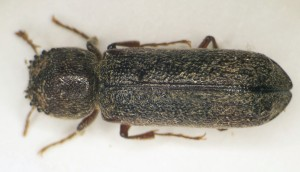Apple Twig Borer
 Scientific Name
Scientific Name
Amphicerus bicaudatus
Hosts
Apple, peach, plum, cherry, pear, apricot, Osage-orange, ash, butternut, pecan, hickory, maple, grape. Apple and grape appear to be favored hosts, but many other trees, especially fruit and nut-producing trees, are readily attacked. Ranges throughout the eastern United States west to the Rocky Mountains.
Life Cycle
Adults emerge in early spring and deposit eggs from
April to June in the bark of twigs and small branches. Young larvae burrow into the twig, usually to the pith, and tunnel along the stem, packing the frass behind them through the summer Larvae mature and pupate in fall and early winter. Many pupae transform to adults in fall. Adu
lts usually hibernate with head downward in the larval galleries through winter. Some adults emerge in fall and move to new, living twigs where they burrow in and overwinter. This twig borer has one generation per year.
Description
Adult. Elongate, cylindrical beetle, about 6 to 13 mm long and 1.2 to 3.5 mm wide. Color uniform for individuals but varies among beetles from reddish brown, dark chestnut brown, brownish black, to almost black. Dorsal surface of body with sparse, short, recumbent, yellowish hairs. Males with two small hornlike tubercles projecting forward on thorax and a smaller tubercle on rear of each elytron. Larva. White with brown head and mandibles, curved body, three pairs of thoracic legs, thoracic segments enlarged; mature larva about 10.2 mm long.
Damage
The insect breeds in injured, diseased, dying, and recently dead trees. However, adult beetles bore into living healthy branches to feed and shelter, usually killing them. Twigs and branches of living hosts may wilt, droop, and die back. Examination of twigs reveals single round entrance holes 3-5 mm in diameter immediately above buds. Dissecting the stem reveals tunnels 5 to 8 cm long, usually extending downward, but sometimes extending up or down or both from entrance holes. A beetle may be found in the tunnel from late fall through winter and spring and sometimes until early summer. Dissection of diseased, dying, and dead infested material reveals larval burrows 8 to 10 cm long, packed with powderlike frass. Heavily infested twigs and branches are sometimes converted to powdered frass. Round exit holes 3-5 mm in diameter are left in the bark by emerging beetles. Occasionally, fruit and ornamental trees, shrubs, and vines have suffered noticeable dieback of small branches.
Control
Infested branches, broken limbs, and prunings should routinely be collected and destroyed. Any wilted and dying branches with hibernating beetles should also be pruned and destroyed. In problem areas, favored wild hosts such as wild grape should be cut and destroyed. Please contact your local county extension office for current information.


